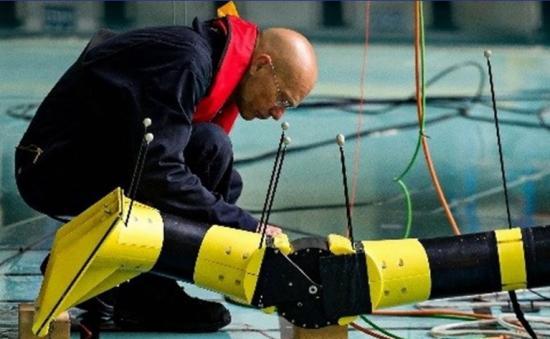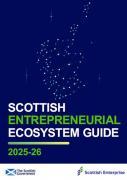Firms Secure £7.7m To Develop Wave Energy Machines
10th January 2019

Two new Scottish wave energy devices will take to the sea in 2020 following the award of £7.7 million from Wave Energy Scotland.
Both winning firms - Edinburgh-based Mocean Energy and AWS Ocean Energy from Inverness - will use the funds to build half-scale wave energy machines and test them in real ocean conditions at the European Marine Energy Centre (EMEC) in Orkney.
It is anticipated this will lead to the technologies being developed at full-scale in the years ahead.
Mocean's technology ‘Blue Horizon' [pictured] is a floating hinged structure; whilst AWS has developed a fully-submerged point absorber named the ‘Archimedes Waveswing’ [pictured].
Commenting on the awards Tim Hurst, Managing Director of Wave Energy Scotland said:"These state-of-the art designs represent the most advanced, and innovative devices in the UK today, and our programme is ensuring that Scotland stays front and centre of the global wave energy story.
"Both devices have already proved their suitability during tank testing and in modelling and the next step is to test them in real-sea conditions. This funding will allow both companies to further develop their designs before building and testing the prototypes in Orkney in 2020, where marine engineering expertise is plentiful.
“The European Marine Energy Centre in Stromness will provide the specialist technical support needed to assess the devices’ performance," Hurst says.
The winning designs were selected following assessment using Wave Energy Scotland’s ‘stage gate’ selection process which assessed the most promising concepts before they proceeded to the next funding stage.
Over the course of four years eight original Wave Energy Converter (WEC) concepts were narrowed down to four. The two winning projects were then selected after a rigorous assessment procedure where Wave Energy Scotland staff and independent external experts worked through a wide set of criteria to evaluate each submission.
The Scottish Government established Wave Energy Scotland in 2014 with the goal of establishing a wave energy industry in Scotland and has since provided more than £30 million to develop commercially available wave energy technologies and sub-systems.
Paul Wheelhouse, Minister for Energy, Connectivity and the Islands said:“With 465,000 square kilometres of seas in Scotland’s Exclusive Economic Zone, Scotland’s capacity to generate wave power is very considerable indeed and wave energy devices represent real game-changers for the industry not only here in Scotland but on a global scale. The Scottish Government’s consistent and long-term support is delivering exciting results as the sector moves from innovation to commercial viability. The deployment of these two devices will represent a strategically important milestone for Scotland, demonstrating technical progress that will support identification of the most cost-effective technologies and encouraging private sector investment in this emerging industry. With our skilled supply chain and expertise in energy innovation, Scotland is ideally positioned to both support and benefit from the expansion of the marine energy sector domestically and globally. I very much look forward to seeing the progress of both devices in the coming months."
Tim Hurst concludes: “We have seen these projects develop from promising concepts into mature, well-developed technologies with excellent performance. Both projects will utilise sub-systems technology developed independently in the Wave Energy Scotland programme. This funding will support real-sea testing to establish the commercial viability of the technology.”
This award of funding by WES is the culmination of a four-year long search for a commercially viable wave energy technology. Contractors from other work strands in the overall WES programme have already begun collaborating with the WEC designers to achieve improved performance, as well as inform possible solutions in the areas of structural materials, control systems and power take-off.
Related Businesses
Related Articles
How Development and Innovation Have Been Supported in the Highlands & Islands Over the Past 60 Years
For 60 years, the Highlands and Islands have been the focus of one of the UK's most distinctive long-term regional development efforts. Since the creation of the Highlands and Islands Development Board (HIDB) in 1965—and its evolution into Highlands and Islands Enterprise (HIE) in 1991.
Planning consent granted for Inverness Campus
Highlands and Islands Enterprise (HIE) has been granted planning permission in principle to progress the second and final phase of development at Inverness Campus. The consent is subject to a Section 75 agreement being finalised between HIE and The Highland Council.Island Business Resilience Fund expansion
Businesses affected by ferry disruption in Coll, Tiree, the Small Isles, Mull, Iona, Ulva, Barra, Vatersay, Islay and Jura can now access financial support. The £4.4 million Islands Business Resilience Fund (IBRF) is expanding to support more businesses experiencing economic impacts linked to travel issues.What the NC500 Research Projects Are Designed to Do - and Why They Matter for the Highlands
As the North Coast 500 approaches its tenth anniversary, it has become one of Scotland's most well-known tourism success stories. The 516-mile loop around the far north of the Highlands has been celebrated internationally, marketed as a world-class road trip, and credited with transforming visitor numbers in some of Scotland’s most remote areas.Workforce North event spotlights Highland economy
EMPLOYERS and educators from across the Highlands have gathered to hear how a new initiative is aiming to transform the region's economy. Workforce North - A Call to Action brought together business leaders and teachers from primary and secondary schools from across the Highland Council area with a wide range of partners geared towards education, learning and skills development at Strathpeffer Pavillion.
Tartan challenge for UHI students offers £1,500 prize
Students from across the University of the Highlands and Islands (UHI) partnership have been challenged to design a tartan and be in with a chance of winning a £1,500 cash prize. Highlands and Islands Enterprise (HIE) has launched THE COMPETITION to mark 60 years since the regional development agency (then named Highlands and Islands Development Board) was established in November 1965.
The Rural AI Roadshow - How AI can help your rural business thrive
Scotland's enterprise agencies (Scottish Enterprise, Highlands and Islands Enterprise, South of Scotland Enterprise) The Scottish AI Alliance and The Data Lab have joined forces to plan and deliver an inspiring and educational Rural AI Roadshow. There will be three, one day, Rural AI Roadshow conferences taking place across Scotland in January 2026.
Digital and AI innovation round-up for November
Scotland's digital future is accelerating, with AI and tech innovation transforming businesses. In this blog, HIE's Theresa Swayne shares November insights on funding, leadership, and how organisations can harness technology to stay ahead.
Reflections from SEWF Rural: global lessons for the Highlands and Islands social impact economy
As we mark 60 years since the region's economic and community development agency was established, it's timely to reflect on the global aspects of our work on shaping rural futures. The recent Social Enterprise World Forum (SEWF) Rural Gathering in Sabah, Malaysia, welcomed changemakers from Australia, Ireland, India, Canada.
Scottish Entrepreneurial Ecosystem Guide - FREE To Download
Scottish Enterprise's Entrepreneurial Ecosystem Guide provides an overview of more than 150 organisations that support new and growing companies in Scotland. The guide includes incubators, accelerators, specialist industry programmes, co-working spaces and networking organisations.

